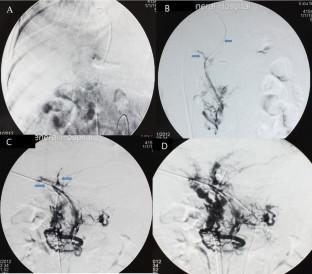Surgical Endoscopy ( IF 2.4 ) Pub Date : 2022-09-23 , DOI: 10.1007/s00464-022-09639-3 Ya-Lin Kong 1 , Jin-Jin Sun 2 , Hong-Yi Zhang 1, 3 , Ying Xing 3 , Cheng Wang 1 , Yang Liu 1, 3 , Xiao-Jun He 1 , Ling-Hong Kong 1 , Cheng-Li Liu 1

|
Background
Portal vein tumor thrombosis (PVTT) secondary to primary liver carcinoma (PLC) is commonly associated with poor prognosis and poses great challenge. This study was to evaluate the efficacy and safety of percutaneous endovascular radiofrequency ablation (RFA) in treatment of PVTT.
Methods
Consecutive patients who were performed endovascular RFA because of PVTT in single-institution in recent 8 years were retrospectively reviewed, compared with patients who underwent only sequential transcatheter arterial chemoembolization (TACE) during the contemporary period. Patency of portal vein, complications, and overall survival (OS) were investigated.
Results
One hundred and 20 patients who underwent endovascular RFA and 96 patients who underwent only sequential TACE were included. No severe complications happened in both groups. Except the higher rates of severe fever and moderate pain in the study group, no difference was found in the incidence of side effects and complications. The effective rate in the study group was (78.3%, 94/120) significantly higher than the comparison group (35.4%, 34/96). The median survival time and 1–3 years cumulative survival rates in the study group were 15.7 months and 42.5%, 21.7%, 2.5%, respectively, and 11.3 months, 21.9%, 9.4%, 0 correspondingly in the comparison group, without significant difference. Type of PVTT and Child–Pugh classification of liver function were independent risk factors, and OS was significantly improved by endovascular RFA and subsequent therapy.
Conclusion
Endovascular RFA is technically safe and feasible for unresectable PLC and PVTT to improve the prognosis and quality of life.
中文翻译:

经皮血管内射频消融术治疗门静脉癌栓的临床评价120例
背景
继发于原发性肝癌 (PLC) 的门静脉瘤栓形成 (PVTT) 通常与不良预后相关,并构成巨大挑战。本研究旨在评估经皮血管内射频消融术(RFA)治疗PVTT的疗效和安全性。
方法
回顾性分析了近 8 年在单一机构因 PVTT 而连续进行血管内 RFA 的患者,并与同期仅接受序贯经导管动脉化疗栓塞术 (TACE) 的患者进行了比较。研究了门静脉的通畅率、并发症和总生存期 (OS)。
结果
120 名接受血管内 RFA 的患者和 96 名仅接受序贯 TACE 的患者被纳入。两组均未发生严重并发症。除了研究组的重度发烧和中度疼痛发生率较高外,副作用和并发症的发生率没有差异。研究组有效率(78.3%,94/120)显着高于对照组(35.4%,34/96)。研究组中位生存时间和1~3年累积生存率分别为15.7个月、42.5%、21.7%、2.5%,对照组分别为11.3个月、21.9%、9.4%、0,无显着差异不同之处。PVTT 类型和肝功能 Child-Pugh 分级是独立的危险因素,
结论
对于不可切除的PLC和PVTT,血管内RFA在技术上是安全可行的,可以改善预后和生活质量。











































 京公网安备 11010802027423号
京公网安备 11010802027423号